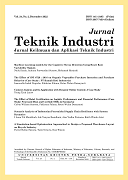Scenario Analysis of Indonesian Ferronickel Supply Chain Resilience with System Dynamics
DOI:
https://doi.org/10.9744/jti.24.2.129-140Keywords:
Supply chain, resilience, ferronickel, system dynamicsAbstract
This study aims to determine the impact of Indonesian government policies on the supply chain resilience of the ferronickel industry in Indonesia. The existing problem is that the law prohibits nickel ore exports, and the policy of industrial downstream causes delays in the process of nickel processing. The problems happen because Indonesia's nickel industry is still incapable of downstream. As a result, the nickel supply chain faces dynamic and complex events that can disrupt operational activities. At the same time, supply chains need to withstand and recover from disruptions quickly. Therefore, Supply Chain Resilience, which is the ability to survive, adapt, and recover from disruptions to meet customer needs, is needed. This study uses system dynamics to analyze complex and dynamic systems to provide more practical policy advice. The system dynamics model starts by building a conceptual model through a system diagram. Inside the model is a causal loop diagram, then proceeds with developing a quantitative stock flow diagram (SFD) model. Finally, this SFD model operated with several scenarios used as policy suggestions for the Indonesian government.
Downloads
References
U.S. Geological Survey, Mineral Commodity Summaries 2022, 22022. doi:10.3133/mcs2022.
Arif. I., Nikel Indonesia, 1st ed. Jakarta: PT Gramedia Pustaka Utama, 2018.
Kementrian ESDM, Undang-Undang No. 4 Tahun 2009 tentang Pertambangan dan Batu Bara, in Undang-Undang Pertambangan Mineral dan Batubara, 2009, p. 4.
Kementrian Perindustrian, Peraturan Menteri Perindustrian No. 73 Tahun 2013 Tentang Peta Panduan Pengembangan Kompetensi Industri Kabupaten Halmahera Timur, in Peraturan Menteri Perindustrian No. 73 Tahun 2013, 2013.
Kementrian ESDM, Executive Summary Pemutakhiran Data dan Neraca Sumber Daya Mineral dan Batubara Status 2019. 2019.
Mancheri, A. Nabeel & Sprecher, Benjamin & Bailey, Gwendolyn & Ge, Jianping & Tukker, Effect of Chinese Policies on Rare Earth Supply Chain Resilience, Resources, Conservation and Recycling, 142, 2018, pp. 101–112. doi: 10.1016/j.resconrec.2018.11.017.
Ivanov, D. Structural Dynamics and Resilience in Supply Chain Risk Management. 2017. doi:10.1007/978-3-319-69305-7.
Mancheri, N. A., Sprecher, B., Deetman, S., & Young, S.B., Raimund, B., Dong, L., Kleijn, R. and Tukker, A., Resilience in the Tantalum Supply Chain, Resources, Conservation and Recycling, 129, 2018, pp.56-69. doi: 10.1016/j.resconrec.2017.10.018.
Shao, L., and Shuzhen, J., Resilience Assessment of the Lithium Supply Chain in China under Im¬pact of New Energy Vehicles and Supply Inter¬ruption, Journal of Cleaner Production, 252, 2020. doi: 10.1016/j.jclepro.2019.119624.
Sterman, J., Business Dynamics: Systems Thinking and Modeling for a Complex World. Massachusetts, USA: McGraw Hill, 2000.
Foresster, J. W., System Dynamics: The Foundation under Systems Thinking. Cambridge, USA: Sloan School of Management Massachusetts Institute of Technology, 2010.
Carvalho, V., Barroso, H., Machado, A., Azevedo,V.H., and Cruz-Machado, S., Supply Chain Redesign for Resilience using Simulation, Computers & Industrial Engineering, 62, 2012, pp. 329–341. doi:10.1016/j.cie.2011.10.003.
Brusset, X. and Teller, C., Supply Chain Capabilities, Risks, and Resilience, International Journal of Production Economics, 184, 2016, pp. 59-68. doi:10.1016/j.ijpe.2016.09.008.
Suherman, I. and Saleh, R., Supply Chain Analysis for Indonesian Nickel, Indonesian Mining Journal, 21(1), 2018, pp. 59–76. doi:10.30556/imj.vol21.no1.2018.246.
Chopra, M., and Sunil, P., Supply Chain Management, Global Edi. 2016.
Hosseini, S., Ivanov, D., and A. Dolgui, Review of Quantitative Methods for Supply Chain Resilience Analysis, Transportation Research Part E: Logistic and Transportation Review, 125, 2019, pp. 285–307. doi: 10.1016/j.tre.2019.03.001.
Croxton, M. K., Fiksel, J., Knemeyer, M., and Polyviou, Resilience of Medium-Size Firms to Supply Chain Disruption: The Role of Internal Social Capital, International Journal of Operations and Production Management, 40(1), 2019,pp. 68-91. doi: 10.1108/IJOPM-09-2017-0530
Hidayatno, A. R., Dhamayanti, A. R., and Destyanto, Model Conceptualization for Policy Analysis in Renewable Energy Development in Indonesia by Using System Dynamics, International Journal of Smart Grid and Clean Energy, 8(1), 2019, pp. 54–58. doi: 10.12720/sgce.8.1.54-58.
Gosh, A., Dynamic Systems for Everyone. Springer, Massachusetts, USA, 2015.
Faezipour, S. M., and Ferreira, A System Dynamics Perspective of Patient Satisfaction in Healthcare, Procedia Computer Science, 16, 2013, pp. 148–156. doi: 10.1016/j.procs.2013.01.016.
Featherston, M., and Doolan, C., Using System Dynamics to Inform Scenario Planning: A Case Study., Proceeding of 31st International Conference of the System Dynamics Society, 2013.
Downloads
Published
How to Cite
Issue
Section
License
Articles published in the Jurnal Teknik Industri: Jurnal Keilmuan dan Aplikasi Teknik Industri will be Open-Access articles distributed under the terms and conditions of the Creative Commons Attribution License (CC BY).
![]()
This work is licensed under a Creative Commons Attribution License (CC BY).



















